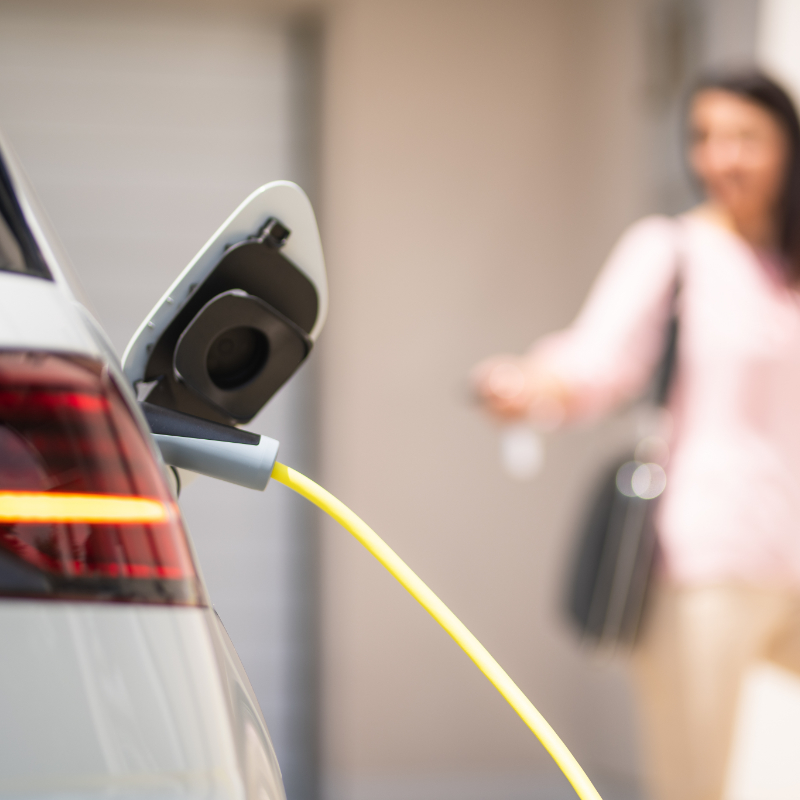Project EnerConnect
Quick charging electric cars from household power outlets, made possible by innovative transistors
On the EnerConnect project, researchers at Fraunhofer IZM are testing bidirectional blocking gallium nitride (GaN) transistors to design a system that could be used with the next generation of active converters and rectifiers. The innovative hardware removes the need for a separate conversion stage and can achieve record 99% efficiency.


Charging electric vehicles in the comfort of one’s own garage is possible – in theory. Compared to commercial quick chargers, it remains an inefficient option: When the alternating current that comes from the home socket is converted to the direct current needed by the electric car, a considerable amount of power is lost in the transition. Even the modern wallboxes owned by many EV owners do not fully solve that fundamental problem.
As part of the EnerConnect project funded by Germany’s Ministry of Education and Research, scientists at the Fraunhofer Institute for Reliability and Microintegration IZM and the Technical University of Berlin have teamed up with their industry partners Delta Electronics Inc., BIT GmbH, and Infineon Technologies AG to produce a system with innovative bidirectional blocking GaN transistors. These transistors bring substantial benefits in terms of power density and efficiency and promise to make charging electric vehicles from commonplace home sockets much more effective.
How do bidirectional GaN transistors work?
Active rectifiers like those used in electric vehicles already use the capabilities of galliumnitride (GaN) or silicon carbide (SiC) semiconductors, which can handle higher switching frequencies in smaller, cheaper passive hardware. However, current systems could lock the voltage in only one direction, unlike bidirectional GaN transistors. These have two gate structures to handle both negative and positive voltages, making the new switching architecture particularly appealing for converters and rectifiers used with the public grid.
The special circuit topology that the researchers are working on has never yet played much of a role in power electronics, as it would have been far too complex with conventional components. The system is called a buck-boost converter, which can work with higher or lower input voltages. The trick lies in the bidirectional blocking transistors, which can seize all of the benefits of this design.
Current practice for electric vehicles is to have active rectifiers operating at high voltages. The new circuit currently being worked on at Fraunhofer IZM would allow the voltage to be lower, in turn reducing the switching losses in the transistor.
The system also allows a conversion stage to be included: Normally, a rectifier needs two separate components for the input voltage to first be increased and then reduced back down to the target battery voltage. Using bidirectional blocking GaN transistors means that these two steps can be streamlined in a single conversion stage, which again improves efficiency by avoiding unnecessary material and reducing the system’s cost.
More efficient transistors not limited to electric vehicles
Both effects mean that the efficiency of the transistors rises to near 99%, while increased switching frequencies and greater power density are also possible with the new architecture. The researchers are working towards a target switching frequency of 300 kHz, which would allow power density to be ramped up to 15 kW per liter – a full 800% over the chargers currently in the market. The technology seems tailor-made for use with electric vehicles, as the converters are fitted on board the vehicles and need to be as small as possible. One goal of the EnerConnect project is to optimize the circuit for use with the public grid to enable fast-charging electric cars even from regular household outlets.
The circuit topology allows electricity to move in both directions, which makes them a perfect choice for the idea of using car batteries as storage for electricity and for use in photovoltaic systems.
The EnerConnect project is scheduled to run from 1 February 2024 to 31 January 2028 at the Fraunhofer Institute for Reliability and Microintegration and the Technical University of Berlin. It is supported by EUR 400,000 in funding, including 80% public funding from the Ministry of Education and Research (funding ID: 16ME0902K) and 10% each from Delta Electronics, Inc. and BIT GmbH. Infineon Technologies AG provides the bidirectional GaN transistors used in the project.
(Text: Steffen Schindler)
Last modified:
 Fraunhofer Institute for Reliability and Microintegration IZM
Fraunhofer Institute for Reliability and Microintegration IZM